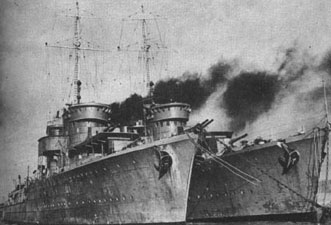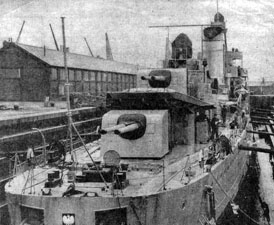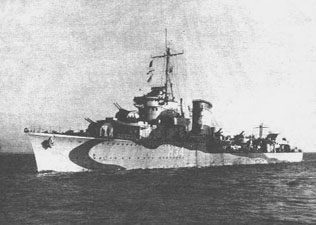|
ORP Blyskawica was launched on 1.X.1936, John Samuel White in Cowes, under command of cmdr. Tadeusz Podjazd-Morgenstern. On 1.XII.1937 Blyskawica arrived in Gdynia and during next year together with Grom, in the mid-August, Blyskawica visited Copenhagen. All the 1939 year Blyskawica spent on drills and works in the sea.
On 30.VIII.1939 Grom, Blyskawica and Burza sailed out from Gdynia directing to Leith, under "Operation Peking". During transition to England, destroyers were spotted by German forces consisting of cruiser Königsberg, one destroyer and two torpedo boats but no action was taken, because the war didn't broke out yet. On 1.IX.1939 squadron reached the shores of England. From 3.IX.1939 Blyskawica was carrying tactical number - H 34. On 7.IX.1939 Blyskawica with other destroyers attacked enemy U-boat but without any success.
 | | Blyskawica and Grom in Plymouth in October 1939 |
On 13.IX.1939 Blyskawica sailed out to Liverpool where she met English transport ship Lassell, with cargo of war supplies for fighting Polish Army, which she was supposed to escort to the Romanian port Galacz. But on 22.IX.1939 after reaching Gibraltar the convoy was stopped and on 26.IX.1939 Blyskawica left Gibraltar in escort of HG-1 convoy. In the beginning of October 1939 Blyskawica was staying in the dock where some heavy equipment was removed, because of her weak steadiness. In the end of October Blyskawica with Grom were searching for the German U-boats in the Irish Sea. On 7.XI.1939 Blyskawica and Grom were attacked, for the first time by torpedo dropped from plane, German Heinkel He-115. On 17.XI.1939 ships were visited by gen. Sikorski. On 16.I.1940 Blyskawica spotted and checked the Latvian steamer Rasma. On her next patrol with Burza, Blyskawica attacked German U-boat, still without any result. In the middle of January some officers denounced to the KMW of cowardice of the commander. Though the commander cmdr. Jerzy Umecki was moved to the reserve, the revolted officers were also moved to the land.
In April 1940 Polish Squadron was rebased to Rosyth from which they were operating during invasion of Norway. On 19.IV.1940 Blyskawica was attacked North of Shetland, by two torpedoes from U 9, luckily both were misses. On 2.V.1940 Blyskawica was slightly damaged by gunfire from land positions. Four days later first enemy plane was shot down and on 9.V.1940 second one. On next day Blyskawica with Burza sailed out to England where she arrived on 18.V.1940 in Harwich.
 | | Blyskawica in dock in 1940 |
In the end of May 1940 'Operation Dynamo' started and Blyskawica was as usual in action. On 29.V.1940 she was attacked by U 60 by two torpedoes. This night Blyskawica towed damaged British destroyer Greyhound with 500 soldiers on deck to Dover. In the night of 30/31.V.1940 Blyskawica again towed allied destroyer, this time French Cyclone which was previously damaged by S 24. Until the mid of August 1940 Blyskawica was staying in repairs. On 21.IX.1940 The Polish Destroyer Flotilla was formed, with Blyskawica, Burza, Garland and Ouragan. The base of Flotilla was Plymouth. From this base patrols in the North Sea and English Channels were made. On 26.X.1940 British Minesweepers Arran damaged Blyskawica's board. The renovation lasted for two month until 3.XII.1940. Already on next day Blyskawica was badly damaged by heavy storm. Blyskawica was staying in repairs for another two months. On 13.III.1941 third enemy plane was shot down, in Glasgow, by Blyskawica's gunfire. On 20.VI.1941 general renovation started in Cowes, where new armament and radars were mounted. New technical data were as follows: 8 x 102 mm (4xII), 4 x 40 mm (2xII), 4 x 20 mm (4xI), 6 torpedo tubes (2 x III; 550 mm), displacement ~2400 t (full load). Renovation ended on 2.XI.1941.
On 30.XI.1941 Blyskawica sailed out to Scapa Flow where she was taking some drills. In January 1942 she was escorting convoys to Iceland (twice British carrier Eagle). On 2.I.1942 Blyskawica sunk abandoned Swedish steamer Shantung. On 5.V.1942 while staying in port of Cowes Blyskawica shot down fourth enemy plane. In the end of 1942 Blyskawica was moved to Mediterranean. On 30.X.1942 Blyskawica was escorting British carrier Furious. On November 1942 she was taking action in 'Operation Torch'. From 8.XI.1942 to 12.XI.1942 Blyskawica was shelling enemy position, escorting allied troops and searching for enemy submarines.
 | | Blyskawica in Summer 1942 |
On 12.XI.1942 Blyskawica was heavily damaged by ~40 German bombers. Until 5.XII.1942 Blyskawica was staying in repairs. On 23.XII.1942 Blyskawica joined Force H and on 18.III.1934 Force Q. On 22.V.1943 Blyskawica left Gibraltar and on 28.V.1943 reached Cowes. Blyskawica was staying in general renovation until the end of November 1943. Until the May 1944 Blyskawica was escorting convoys to the Murmansk, and patrolling North Sea. On 23.V.1944 she joined 10th Destroyers Flotilla. On night battle near Quessant on 8/9.VI.1944 Blyskawica took part in sinking of Nazi destroyer Z 32 and ZH 1. For three months (June-August 1944) Blyskawica was patrolling Biscay Bay. On 15.VII.1944 together with British Tartar and Canadian Haida sunk two auxiliary minesweepers UJ 1420 and UJ 1421 and probably one unknown ship. In October 1944 Blyskawica was escorting convoys near British Isles. From 4.II.1945 to 5.VII.1945 Blyskawica was staying in renovation. In November 1945 Blyskawica took part (as flagship) in 'Operation Deadlight' when she sunk several U-boats: U 2321, U 481, U 1198, U 295, U 368, U 155, U 861, U 825.
On 5.I.1946 Blyskawica sailed to Rosyth where she was joined by the rest of the Polish fleet: cruiser Conrad and destroyers Garland and Piorun. On 28.V.1946 Blyskawica was transferred to British. But on 1.VII.1947 again Blyskawica is under Polish Flag and three days later on 4.VII.1947 under command of famous submarine commander cpt. Boleslaw Romanowski Blyskawica entered the Gdynia harbour. After return to Poland Blyskawica was rearmed (she was converted to Russian armament) and received new Soviet radars (instead of taken off British ones). From October 1949 to April 1950 she was staying in general renovations. British 102 mm AA guns were replaced by Russian 100 mm guns and British 40 mm and 20 mm by Soviet 37 mm. Another and final general renovation lasted from 15.X.1957 to 14.IV.1961. From now on Blyskawica was a part of Peoples Polish Navy. For three times she was the best ship in Navy: in 1951, 1964 and 1966. On 11.VI.1969 she was moved to reserve and in 1975 she was converted to the museum-ship and on 1.V.1976 she stared new period in her long carrier. In 70-s and 80-s about 200 000 per year was visiting Blyskawica, in 90-s only about 100 000 visitors per year.
In 1985 Society of Friends of ship Blyskawica was founded. In order to maintain it's status as a national monument and symbol of Polish naval history, the ship is in need of constant maintenance and repairs. Donations for the preservation of the the ship should be addressed to:
Towarzystwo Przyjaciół Okrętu Muzeum "Błyskawica"
Bank PKO BP I Oddzial Gdynia
Account # 10201853-235024-270-1
Okret ORP Blyskawica
Muzeum Marynarki Wojennej
Skwer Kosciuszki
Gdynia, Poland 81-912 |
|